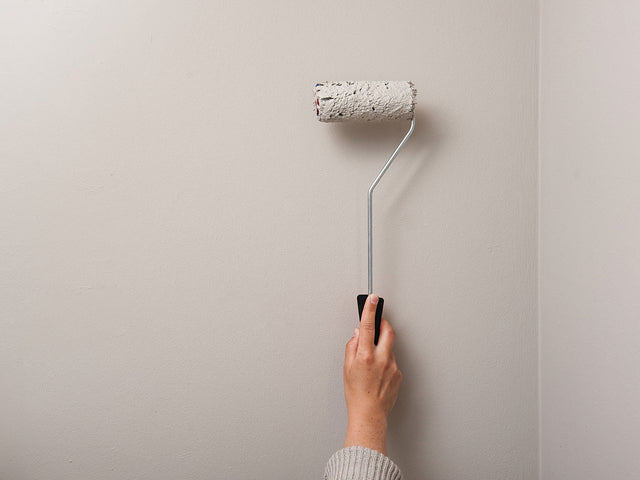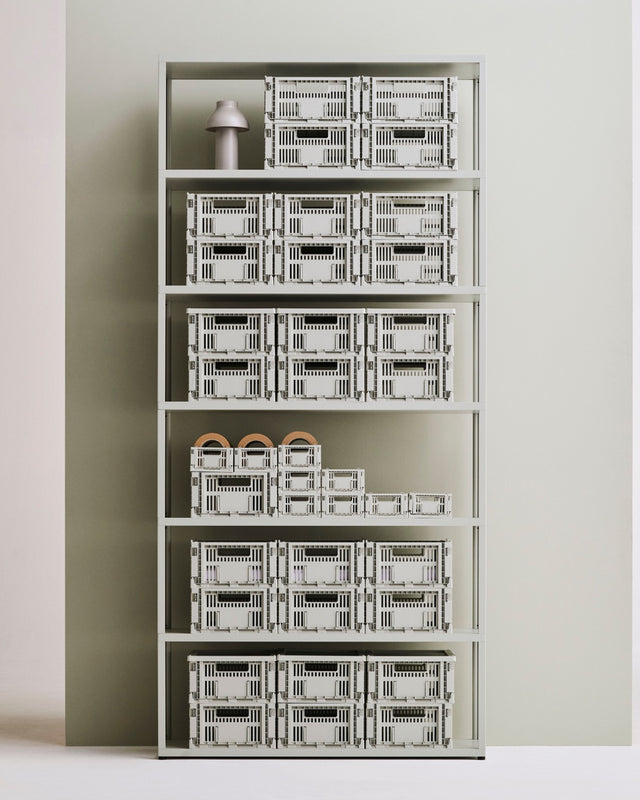We have now painted almost every wall in our apartment at least once. I admit that not everyone shares this hobby and many people feel sick at the thought of brushes and paint. However, it must be said: You have all sorts of opportunities in life to paint walls and there are always situations where you just can't avoid it. That's why I've made it my mission to write the ultimate "How to paint walls guide". After the first few hundred square meters, you've picked up a few tricks and tips that make the whole thing much easier and you've made one or two faux pas. I want to share these experiences with you so that in the future you can pick up the brush with the same joy as we did. Because I can promise you one thing in advance: Nothing is as satisfying as freshly painted walls.
The right tool
As with almost everything, the right tools make all the difference. Nothing is more frustrating than missing something or getting the wrong thing. So here is a list of everything you really need to paint walls:
- paint rollers and roller holders
You definitely need two different rollers. For the large areas, you need a roller that is 18 to 22 cm wide and a so-called radiator roller. This has a narrower roller (so that it fits behind radiators). It is better to go for the more expensive roller here. You can wash it out and reuse it many times after painting. Your money is well spent here. In addition, most cheap rollers absorb less paint. So you have to dip the roller more often to paint the same area. - telescopic pole
A telescopic pole makes your work so much easier. Not only can you reach the upper part of the walls and the ceiling without a ladder, but you can also paint the lower part of the walls without bending down. - Paint brush
We always have two brushes with us for painting: First, a small round brush. This is great for getting into corners and painting strips, pipes, etc. in no time at all. Second, a radiator brush. This allows you to get into hard-to-reach places. - painter's fleece
Let's be honest: This won't be the last time you paint a wall. That's why it's time to buy a painter's fleece. You use it to cover the floor, just like you would with foil, but unlike foil, the fleece rolls out super quickly, doesn't keep slipping, doesn't make any annoying noises when you work, and best of all: it's reusable! - film
Unfortunately, in some situations you have to resort to the unpopular foil. For example, if you are painting the ceiling you have to cover the entire floor. Unfortunately, this is quite time-consuming with fleece. Often you also have furniture in the room that you cannot get out of the room. You should also cover this after you have pushed it into the middle of the room. - painter's tape
The same applies here: it's better to spend a little more and not be annoyed afterwards. The hardest part of painting is the masking. Don't make it even harder for yourself by using cheap masking tape. - drip tray and paint bucket
In most cases, the bucket you buy the paint in is so small that you can't get the large roller into it. That's why you definitely need a larger bucket to pour the paint into. You also need a drip tray. This does exactly what the name suggests. It ensures that you don't have too much paint on the roller and it doesn't drip when you paint.
Buy paint
Regardless of whether you just want to paint your walls white or bring a little color into your room, all wall paints have one thing in common: the cheap ones are no good! Unfortunately, we have often had the experience of cutting corners here.
A high-quality wall paint usually covers the surface with the first coat (saves a lot of time), ensures an even result (so it is also suitable for complete beginners) and drips little to not at all (so it keeps the apartment clean). Here you can find our own wall paints, which we produce in collaboration with Kolorat.
How much paint you need is usually written on the paint itself. But it's better to calculate with a little more. This isn't because the manufacturer is cheating you, but because you're just not painting that efficiently at the start of your painting career.
Preparation
Before you start painting, it's a good idea to take a look at the walls you want to paint. It's best to pull out all the nails and screws that you no longer need and fill in the holes. The filler should ideally be left to harden for 24 hours before you paint over it. It can also be a good idea to check whether the plaster is sticking firmly to the wall or will come towards you when you paint. To do this, take a long piece of masking tape and stick it firmly to the wall. Wait a minute and then peel it off again. If old paint or even plaster sticks to the tape, that's a bad sign. In this case, you should brush the wall heavily with primer before you start.
sockets
Many people simply cover the sockets with tape and then paint around them. I can understand that. Fiddling around with electrical installations is definitely not for beginners. But I want to reassure you at this point. Removing the socket and light switch covers from the wall is super easy, super safe and produces a great result.
The most important thing: remove the fuse! After you have removed the fuse for the room you want to paint, you should definitely check whether the power is really gone. To do this, plug a lamp or something else into each socket to make sure.
Once the power is off, you can remove the covers from the sockets. To do this, you just need to loosen the small screw in the middle of the socket and then pull off the cover. It's even easier with switches. These are usually not screwed on, but simply plugged in. If you pull on the frame, they should come off quite easily.
masking
Now comes the worst part of all: masking. But here too, there are a few tips that can help you. Of course, you took my tip above to heart and bought good painter's tape. Not the cheap stuff that you get in a pack of three at the checkout at the hardware store, but the expensive stuff that really hurt when you put it in the cart. But even the best tape doesn't stick to dust very well. That's why you should vacuum all the surfaces that are about to be masked.
When you've done that, you can start masking. It's best to tape long sections in as long pieces as possible. That way, the edge will be cleaner afterwards. There's also a simple trick where the tape has to go around corners: first you stick a longer piece to one side of the corner and then just put a short piece around it. Then you start with a new piece of masking tape. Some corners are particularly complicated. We have such candidates especially in the sloping roofs. In such a case, you simply tape over it and then use a knife to cut your masking tape to size directly on the wall. Don't worry about the wall. The thin slit from the knife will be covered with paint straight away and will then no longer be visible.
painting walls
Finally, the time has come: you can swing the brush! This is of course the fun part, but you can also make your life easier here:
- Find a prank partner
Everything is better when you're two people, including painting. You also get things done twice as quickly when you're two people, and the rather boring task of painting walls becomes a little event. - Music!
Painting is a dull and monotonous activity, but with the right music in the background, it's pure joy. Here 's the link to our favorite painting playlist. - Not too deep
Most people make the mistake of pressing the roller completely into the paint. However, your roller only has its fluffy fur on the outside that absorbs the paint. Therefore, it is better to dip the roller more often from different sides and not quite so deeply (then there will be less splashing and you will need less paint). - Drain
Do you remember the drip tray? Now is a good time to hang it in your paint bucket. After you have dipped your roller in the paint, roll it over the tray a few times. This way the excess paint goes back into the pot, there is less dripping when painting and you need less paint. - Blending
Always paint large areas in overlapping layers. This will give you a smoother result. - window closed
If your paint dries more slowly, you have more time to paint and your result will be more even. The high humidity does cause you to sweat more while you work, but it's worth it. - First vertically, then diagonally
First paint all walls vertically, i.e. from top to bottom. Then go across the wall again. This way you distribute the paint evenly. - Beer
Nothing makes you thirsty for beer like painting walls. Always make sure you have enough (well chilled if possible). This way you can keep your painting partner happy too
You should be finished soon and even the last corner will shine in new splendor thanks to fresh paint. Luckily, tidying up is always the quickest part.
Clean up
Your wall is finished painting and the fresh color puts a smile on your face? Then it's time to clean up.
It's best to remove the tape first. Nothing is as difficult to remove from the wall as painter's tape that has been stuck there for weeks.
If you don't use any paint, simply pour it back into the bucket it came in. You can use the radiator brush to scrape the paint out of your paint bucket.
Wash rollers, brushes, paint buckets and drip trays under running water. Your rollers are clean when only clear water comes out when you squeeze the roller. To get every last bit of paint out of the rollers, you can then wrap them in Zewa. This will suck the last remaining color pigments out of the roller.
Now all you have to do is reattach the sockets and switches and put the fuse back in – done.


